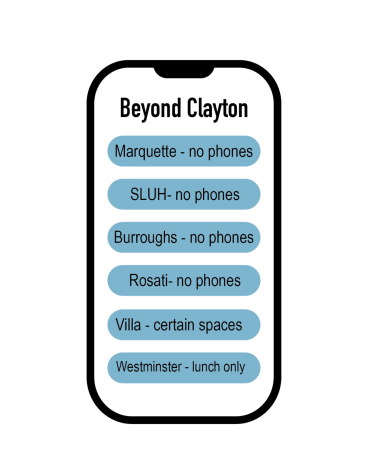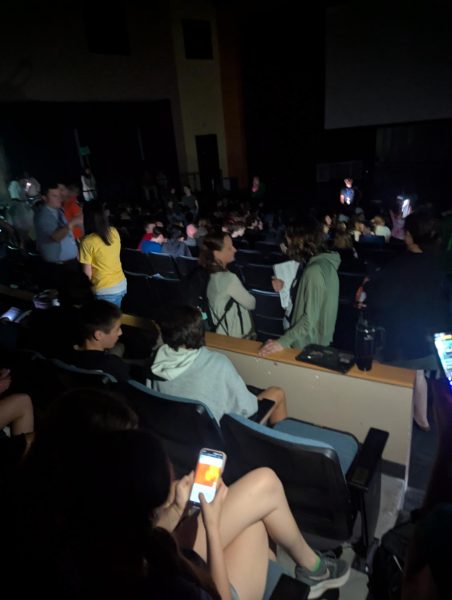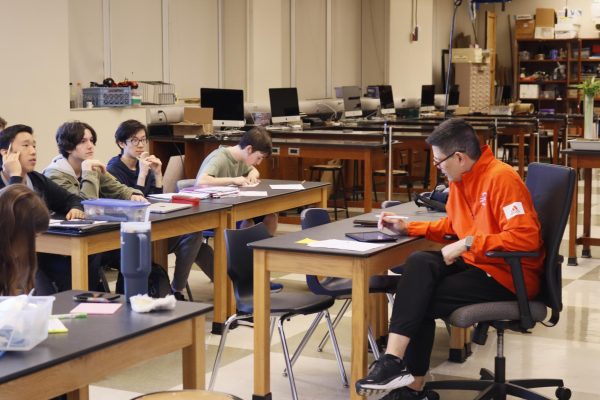The Phone Conundrum
As phones proliferate in classrooms, teachers and students wonder what role they should play.
The School District of Clayton’s official technology policy lists the following as an example of misconduct: “Using, displaying or turning on pagers, phones, personal digital assistants, personal laptops or any other personal electronic devices during the regular school day, including class change time, mealtimes or instructional class time, unless the use is part of the instructional program.” Although this policy is supposed to instruct students and teachers about technology usage at school, it’s unlikely that most students have ever even seen a pager. In 2022, we’re seeing new technology shape schools like never before.

According to a study from NPR, six in ten students do homework on a computer every day. The internet has become a useful tool for students to learn and has undoubtedly changed the way schools operate. However, not all aspects of technology in schools have aided students’ learning. Recently, battles around cell phones in class have increased and created an intense rift between teachers and students. Clayton’s outdated technology policy, which leaves lots of room for interpretation, has resulted in many different phone policies within the district.
At Wydown, the district’s middle school, students aren’t allowed to have their phones out at any time during the school day, even during recreational hours like lunch. The Wydown policy has changed dramatically in recent years mainly due to COVID-19. During the height of the pandemic, students had to eat outside in the school’s parking garage.
Jamie Jordan, Wydown’s principal, said, “Because of that, the kids couldn’t hear each other, or talk to each other, and it was loud. So, we decided, to be fair, we would let kids have their cellphones to play games or text each other.”
After the school returned to more normal operations many still noticed a large reliance on phones during the school day. Additionally, many were concerned that students would use phones outside of the classroom to avoid connecting with their peers. “Some parents came with lots of concerns about their kids not talking with each other,” said Jordan.
Not seeing another alternative, Jordan said, “We decided we would go cold turkey.”
Since the shift, Jordan and the other Wydown teachers have noticed stark improvements in the school’s environment.
Students have been surprisingly receptive to the policy. “It’s been great. Jordan said. “I was really worried at first, but the eighth graders have been awesome. We may take one or two phones for the whole day.”
Overall, Jordan sees the new phone policy as a striking success, but still recognizes the importance of flexibility. “This is always something we look at and evolve and try to figure out what’s best for the kids,” she said. “It’s nothing that’s ever ‘this is what we’re going to do for the rest of time,’ but this is what’s working for us right now.”
At the high school, the story is a bit more complicated. Both teachers and students have recognized the existence of problematic phone usage, but controversy exists over how to best remediate the problem.
Kyle McCord, CHS math teacher, noticed that ever since remote learning students are getting distracted on their phones more often during class. He said, “I feel like the stamina to sit through a whole class period has become harder, so the phone comes out as a distraction piece.”
Students agree that being online increased their reliance on their phones. Casey Piston, CHS junior, said “During remote learning, I was able to use my phone so often, I would just zone out during classes. That led me to believe, ‘if I can do fine with my phone online, why can’t I be trusted to handle it in class?’”
To combat in-class phone usage some teachers, like social studies teacher Amy Doyle, have assumed a strict policy similar to Wydown. At the beginning of each class, Doyle’s freshmen and sophomore students are required to place their phones in a shoe rack. Doyle explained the reason for her policy saying, “After many conversations with my colleagues and reading a number of studies, I have decided to follow a growing trend to allow students to have a break from the distractions and problems that may correlate to increased phone use.”
Students are split about policies that require them to not be in possession of their phones. Ashleigh Horan, CHS junior, said, “I think putting your phone up on the phone holder is good. […] I can see how much I relied on my phone during remote learning. Anytime I got bored I could text somebody, but at school, you can’t do that.”
On the other hand, some feel like taking phones creates a distrustful dynamic between students and teachers. “When teachers take your phone, especially on the first day of school, I feel like it creates an atmosphere of preemptive distrust in students,” explained Piston.
Not all strict policies require students’ phones to be taken. In English teacher Sean Rochester’s classroom, students are allowed to have their phones on them, but they aren’t to be used at any time during class.
“My typical method of teaching […] requires all students to remain engaged at all times, which means no phone moments,” he explained. “In very simple terms, when students go to their phones, they’re turning their brains away from the learning”
While phones can occasionally be used as useful tools, Doyle thinks they should no longer have a place in the classroom.
“If you would have asked me that five years ago, I would have said they are a great resource… However, now that we know how detrimental they can be to mental health, the learning process, and making connections with people in the class, I think the costs outweigh any benefits.”
Rochester said he thinks using phones during class is, a “‘Special’ moment, not the norm.”
Not all teachers think a complete ban in the classroom is productive.
McCord elects for a less strict policy. He doesn’t allow phones while teaching but has no problem if phones are used during breaks in class.
“The reason I’m being this way with my phone policy is partly that I teach upperclassmen,” he said. “So I’m trying to help with the transition into a college-level class.”
Preparing students for the world beyond high school is an important aspect of crafting a phone policy. Even Jordan recognizes that less restrictive policies may be more suitable for older kids. “Juniors and seniors have jobs and lives and drive cars. I don’t know if saying ‘you can’t have a phone at all would work,” she said.
Furthermore, phones can be used to help students who otherwise struggle with school.
“I don’t think [strict phone policies are] fair all the time because phones can be used as accessibility devices,” said Ezri Perrin, a junior, “There are people who need to listen to music while they work. Some people need to use their phones to speak because they can’t speak normally.”
Phones also provide a welcome break from the otherwise monotonous nature of the school. Horan noted that “Sometimes using phones as a part of the class can make it more interesting.”
McCord notices that his students use phones in unique ways to aid their learning. From zooming in on the board when they forget their glasses, or quickly using the calculator app, phones can be used for reasons other than simply distraction.
Students also notice the hypocrisy in completely banning phones during the school day, “If you asked any teacher to go the full day without their phone, I think it would be very challenging for them,” said AnMei Deck, a junior. “I understand that teachers want us to be focused and engaged in class, but taking away a student’s personal property doesn’t seem like the answer.”
For better or worse, phones aren’t going anywhere in the near future. Educators have an opportunity to teach kids how to use their phones in a productive and respectful way. As teachers and administrators attempt to create a phone policy that fosters the best learning experience for students, they should keep in mind the importance of flexibility. What works for one classroom may not work in another. What works in 2022 may not work a year from now. The role of phones at school will no doubt continue to change and evolve for many decades to come, but the true question lies in whether or not we can change with it.
A $50 or more donation includes a subscription to the Clayton High School Globe 2024-2025 print news magazine.
We will mail a copy of our issues to the recipients of your choice.
Your donation helps preserve the tangible experience of print journalism, ensuring that student voices reach our community and that student democracy thrives.

JiaLi Deck is a senior. When she first joined the Globe her sophomore year, she couldn't have ever imagined being Editor in Chief; however, as time went on she realized how passionate...











